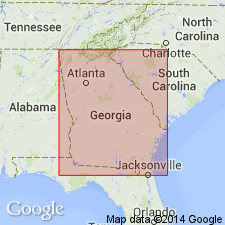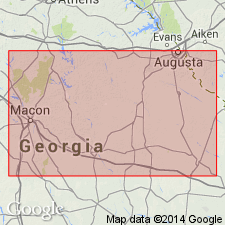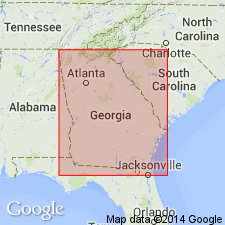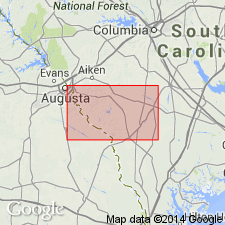
- Usage in publication:
-
- Dry Branch Formation
- Modifications:
-
- Named
- Dominant lithology:
-
- Sand
- Clay
- AAPG geologic province:
-
- South Georgia sedimentary province
Summary:
Dry Branch Formation of Barnwell Group named in this report for community in Twiggs Co., GA. Consists of fossiliferous sand, calcareous sand, clay, and montmorillonite clay and ranges from 9 to 54 m thick. The following three distinct but interfingering and intergrading lithofacies recognized as formal members in some areas: Twiggs Clay Member, Irwinton Sand Member, and Griffins Landing Sand Member. Overlies Clinchfield Formation of Barnwell Group or Tivola Limestone of Ocala Group. Conformably underlies Tobacco Road Sand of Barnwell Group. Age is late Eocene.
Source: GNU records (USGS DDS-6; Reston GNULEX).

- Usage in publication:
-
- Dry Branch Formation
- Modifications:
-
- Overview
- Areal extent
- AAPG geologic province:
-
- Atlantic Coast basin
- South Georgia sedimentary province
Summary:
Unit is formally named in this paper but was annotated for Bulletin 1564 (Lexicon) from 1979 Open-File report. Name has been used frequently in the six intervening years. The Dry Branch extends from Dooly Co., GA, to Lexington and Orangeburg Cos., SC. It includes the Twiggs Clay, Irwinton Sand, and Griffins Landing Members. Underlies Tobacco Road Sand and overlies Clinchfield Formation, both of Barnwell Group. Interfingers with Ocala Group, where Twiggs Clay Member separates the Ocmulgee Formation from the Tivola Limestone. Age is late Eocene (early Jacksonian).
Source: GNU records (USGS DDS-6; Reston GNULEX).

- Usage in publication:
-
- Dry Branch Formation
- Modifications:
-
- Revised
- AAPG geologic province:
-
- South Georgia sedimentary province
Summary:
In central GA, the Dry Branch includes the Tivola Limestone Member at its base and the Twiggs Clay Member at its top.
Source: GNU records (USGS DDS-6; Reston GNULEX).

- Usage in publication:
-
- Dry Branch Formation*
- Modifications:
-
- Mapped 1:100k
- Dominant lithology:
-
- Sand
- Marl
- Clay
- AAPG geologic province:
-
- Atlantic Coast basin
Summary:
Pg. 10-11, 14, 21, geol. map. Dry Branch Formation, middle formation of Barnwell Group. Shallow shelf to tidal flat deposits representing regression of the sea. Includes (ascending), not separately mapped: Griffins Landing Member, calcareous, fossiliferous, clayey sand and marl; Twiggs Clay Member, laminated carbonaceous clay; and Irwinton Sand Member, massive, well-sorted sand. Overlies Clinchfield Formation and underlies Tobacco Road Sand, both of Barnwell Group. Age is late Eocene (early Jacksonian), based on fossils. Samples from dark-green carbonaceous clay and marl in Griffins Landing Member yielded dinoflagellate assemblages of late Eocene (early Jacksonian) age (L.E. Edwards, USGS, written commun., 1986; Prowell and others, 1985, USGS MF-1737).
Best exposures in quadrangle: Twiggs and Irwinton Members exposed in large roadcut on Windsor Spring Road just south of Butler Creek near Augusta, GA. Griffins Landing Member exposed on west side of Savannah River at Griffins Landing.
Source: Publication.
For more information, please contact Nancy Stamm, Geologic Names Committee Secretary.
Asterisk (*) indicates published by U.S. Geological Survey authors.
"No current usage" (†) implies that a name has been abandoned or has fallen into disuse. Former usage and, if known, replacement name given in parentheses ( ).
Slash (/) indicates name conflicts with nomenclatural guidelines (CSN, 1933; ACSN, 1961, 1970; NACSN, 1983, 2005, 2021). May be explained within brackets ([ ]).

